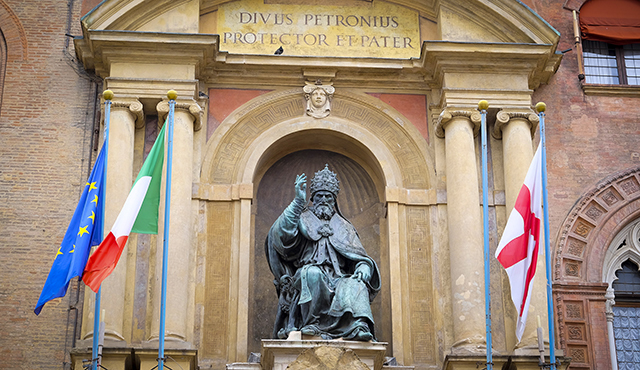In daily life, the calendar is essential in marking moments both significant and mundane, whether it’s a doctor appointment, personal milestones such as birthdays, or terrible tragedies such as 9/11.
The point of a calendar is to keep track of things not to be forgotten. For Catholics, the liturgical calendar is an intrinsic part of remembering the life of Jesus Christ.
“We follow our traditions and our practice and expressions of faith through the calendar,” says Fr. Troy Schneider, parochial vicar at Holy Family Cathedral in Orange. “There is a rhythm that mirrors the life, suffering and death of Jesus Christ in the calendar. These are our seasons.”
The calendar is not some abstract, distant reality; it’s an ever-present invitation for Catholics to experience anew and live as Christ and the saints in one’s own life, says Monsignor Arthur A. Holquin, episcopal vicar for Divine Worship for the Diocese of Orange.
“The liturgical calendar invites us to journey with the Lord and his holy ones, and we imagine and experience sacramentally the saving mysteries and the grace flows from that,” Holquin says. “In other words, the calendar is an invitation for us to prepare our heart and mind to embrace the incarnated Christ in our own lives, celebrating the journey of our Lord to Jerusalem and experience the grace of redemption through his cross and resurrection or to be with the disciples in the upper room for the birth of the church at Pentecost.”
And because it closely follows Christ’s life, the liturgical calendar takes on consecrated significance.
“At the heart of the Christian faith is the belief that God entered time and we call that the incarnation,” Holquin says.
When God took human flesh in time, time became transformed and in a very real sense became sacred for Christians, he says.
“Jesus and his ministry were exercised at a particular time and we view time as sacramental with a small ‘s’ — that time holds the potential of revealing or disclosing the holy to us,” Holquin says.
The liturgical calendar consists of six seasons that starts with Advent, the four weeks leading up to the birth of Christ, and follows with Christmas, Lent (40 days of penance and fasting), the Sacred Paschal Triduum (the three holiest days of the year commemorating Christ’s suffering, death, and resurrection), Easter and Ordinary Time, the two stretches of time after Christmas and Easter that focus on Christ’s teachings.
While the liturgical calendar starts with the advent season, its actual creation is rooted in Christ’s death and resurrection. In the first and second centuries, early Christians adopted their version of the Jewish Sabbath — a chosen day in the week to rest and reflect — as a weekly way to remember Christ.
“The first important feast of the calendar is Sunday, and Sunday remembers the Lord’s Resurrection,” Holquin says. “Christians gathered on the first day of the week, Sunday, the first of the days connected to the calendar.”
In the second Century, Easter, the ultimate Sunday celebration, was among the first events marked on the liturgical calendar. (Christmas would follow later. Although Christ’s incarnation was honored in some form in the early days of Christianity, the first formal feast of Christ’s nativity wasn’t established until the fifth century by Pope Leo I.)
Determining when to celebrate Easter became the catalyst for the Gregorian calendar, the solar calendar now followed throughout the world. Both calendars were being developed concurrently in the years leading up to 1582, when Pope Gregory XIII introduced the calendar as a way to correct the Julian calendar and align the lunar cycle to the time of year the early church celebrated Easter.
It took awhile for the rest of the world to adopt the calendar since Pope Gregory’s reach was limited to the Catholic Church. But Philip II of Spain’s decision to switch from Julian to Gregorian calendar impacted much of heavily Roman Catholic Europe. Other countries would eventually follow suit, including Britain and the territory that would become early America in 1752.
Meanwhile, the liturgical calendar evolved into a more complicated system, and by the seventh or eighth century, the general outline of the calendar widely known today took shape. Other major events were honored, such as Pentecost and Ascension. Also added were days honoring the heroes of the faith, including Mary, the mother of God, and the saints who emulated Christ and/or were martyred for their belief in Him.
Pope Pius V in 1568 declared that the universal calendar setting the feast days and their dates which would be celebrated throughout the whole Church.
The liturgical calendar would take on several reforms over the years, most recently with the Second Vatican Council. Popes have also re-evaluated the calendar, adding or removing the number of feast days of saints over the years. One of the more recent feast days added to the calendar was the Sept. 5 feast day of Mother Teresa, now Saint Teresa.
Today, the liturgical calendar is followed by millions of Catholics around the world, creating what Schneider calls the collective heartbeat of the church.
“Our prayer, our liturgy becomes — literally in Greek ‘leitourgía’ — the work of the people,” he says. “And how do we express the work of the people? Through prayer. And it’s through prayer, liturgy, that we hear the heartbeat of Christ. It’s one of the things that help unite us as Catholics.”

